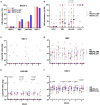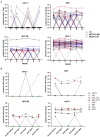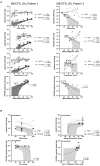Salivary DNA Loads for Human Herpesviruses 6 and 7 Are Correlated With Disease Phenotype in Myalgic Encephalomyelitis/Chronic Fatigue Syndrome
- PMID: 34422848
- PMCID: PMC8378328
- DOI: 10.3389/fmed.2021.656692
Salivary DNA Loads for Human Herpesviruses 6 and 7 Are Correlated With Disease Phenotype in Myalgic Encephalomyelitis/Chronic Fatigue Syndrome
Abstract
Myalgic Encephalomyelitis/Chronic Fatigue Syndrome (ME/CFS) is a complex chronic condition affecting multiple body systems, with unknown cause, unclear pathogenesis mechanisms, and fluctuating symptoms which may lead to severe debilitation. It is frequently reported to have been triggered by an infection, but there are no clear differences in exposure to, or seroprevalence of, any particular viruses between people with ME/CFS and healthy individuals. However, herpes viruses have been repeatedly hypothesized to underlie the chronic relapsing/remitting form of MS/CFS due to their persistence in a latent form with periodic reactivation. It is possible that ME/CFS is associated with herpes virus reactivation, which has not been detectable previously due to insufficiently sensitive testing methods. Saliva samples were collected from 30 people living with ME/CFS at monthly intervals for 6 months and at times when they experienced symptom exacerbation, as well as from 14 healthy control individuals. The viral DNA load of the nine humanherpes viruses was determined by digital droplet PCR. Symptoms were assessed by questionnaire at each time point. Human herpesvirus (HHV) 6B, HHV-7, herpes simplex virus 1 and Epstein-Barr virus were detectable within the saliva samples, with higher HHV-6B and HHV-7 viral loads detected in people with ME/CFS than in healthy controls. Participants with ME/CFS could be broadly separated into two groups: one group displayed fluctuating patterns of herpesviruses detectable across the 6 months while the second group displayed more stable viral presentation. In the first group, there was positive correlation between HHV-6B and HHV-7 viral load and severity of symptom scores, including pain, neurocognition, and autonomic dysfunction. The results indicate that fluctuating viral DNA load correlates with ME/CFS symptoms: this is in accordance with the hypothesis that pathogenesis is related to herpesvirus reactivation state, and this should be formally tested. Herpesvirus reactivation might be a cause or consequence of dysregulated immune function seen in ME/CFS. The sampling strategy and molecular tools developed here permit such large-scale epidemiological investigations.
Keywords: Clinical specimens; DNA viral load; ME/CFS; digital droplet PCR; human herpesvirus.
Copyright © 2021 Lee, Lacerda, Nacul, Kingdon, Norris, O'Boyle, Roberts, Palla, Riley and Cliff.
Conflict of interest statement
The authors declare that the research was conducted in the absence of any commercial or financial relationships that could be construed as a potential conflict of interest.
Figures






References
-
- Kingdon CC, Bowman EW, Curran H, Nacul L, Lacerda ME. Functional status and well-being in people with myalgic encephalomyelitis/chronic fatigue syndrome compared with people with multiple sclerosis and healthy controls. Pharmacoecon Open. (2018) 2:381–92. 10.1007/s41669-018-0071-6 - DOI - PMC - PubMed
-
- Estevez-Lopez F, Mudie K, Wang-Steverding X, Bakken IJ, Ivanovs A, Castro-Marrero J, et al. . Systematic review of the epidemiological burden of myalgic encephalomyelitis/chronic fatigue syndrome across europe: current evidence and EUROMENE research recommendations for epidemiology. J Clin Med. (2020) 9:1557. 10.3390/jcm9051557 - DOI - PMC - PubMed
Grants and funding
LinkOut - more resources
Full Text Sources

